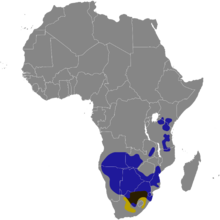Wildebeest
| Wildebeest Temporal range: 2.5–0 Ma Early – current |
|
|---|---|
 |
|
| Male C. t. albojubatus Ngorongoro Crater, Tanzania |
|
 |
|
| Male C. t. taurinus Tswalu Kalahari Reserve, South Africa |
|
| Scientific classification | |
| Kingdom: | Animalia |
| Phylum: | Chordata |
| Clade: | Synapsida |
| Class: | Mammalia |
| Order: | Artiodactyla |
| Family: | Bovidae |
| Subfamily: | Alcelaphinae |
| Genus: |
Connochaetes Hinrich Lichtenstein, 1812 |
| Species | |
|
Connochaetes gnou – black wildebeest |
|
 |
|
| Range map: Black wildebeest shown yellow Blue wildebeest shown blue Overlapping range shown brown |
|
Connochaetes gnou – black wildebeest
Connochaetes taurinus – blue wildebeest
The wildebeests, also called gnus, or wildebai, are a genus of antelopes, Connochaetes. They belong to the family Bovidae, which includes antelopes, cattle, goats, sheep and other even-toed horned ungulates. Connochaetes includes two species, both native to Africa: the black wildebeest, or white-tailed gnu (C. gnou); and the blue wildebeest, or brindled gnu (C. taurinus). Fossil records suggest these two species diverged about one million years ago, resulting in a northern and a southern species. The blue wildebeest remained in its original range and changed very little from the ancestral species, while the black wildebeest changed more in order to adapt to its open grassland habitat in the south. The most obvious way of telling the two species apart are the differences in their colouring and in the way their horns are oriented.
In East Africa, the blue wildebeest is the most abundant big game species; some populations perform an annual migration to new grazing grounds, but the black wildebeest is merely nomadic. Breeding in both takes place over a short period of time at the end of the rainy season and the calves are soon active and are able to move with the herd. Nevertheless, some fall prey to large carnivores. Wildebeest often graze in mixed herds with zebra which gives heightened awareness of potential predators. They are also alert to the warning signals emitted by other animals such as baboons. Wildebeest are a tourist attraction but compete with domesticated livestock for pasture and are sometimes blamed by farmers for transferring diseases and parasites to their cattle. Some illegal hunting goes on but the population trend is fairly stable and some populations are in national parks or on private land. The International Union for Conservation of Nature lists both as least-concern species.
...
Wikipedia
